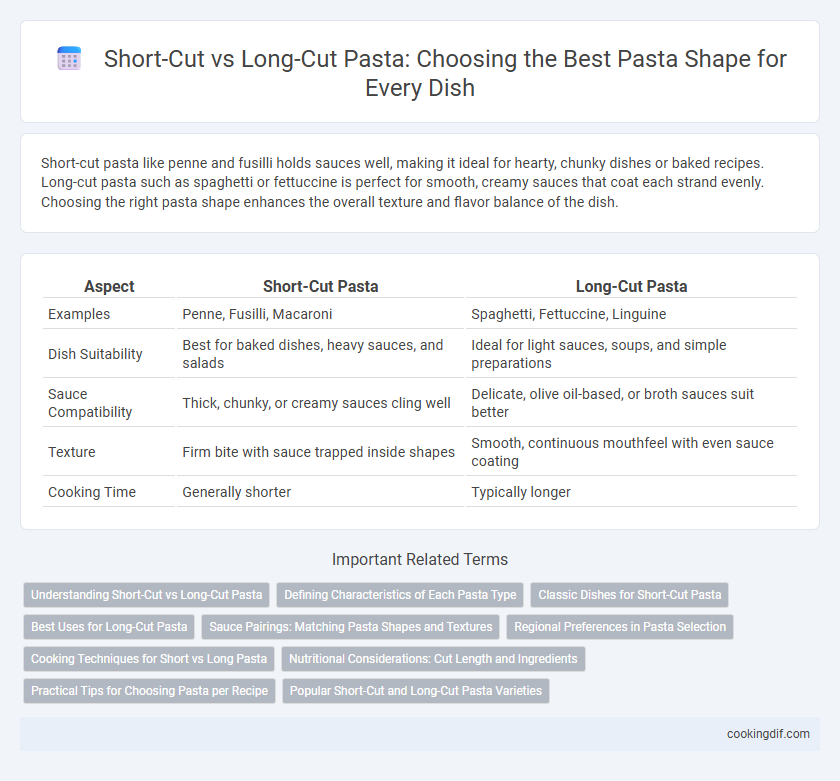Short-cut pasta like penne and fusilli holds sauces well, making it ideal for hearty, chunky dishes or baked recipes. Long-cut pasta such as spaghetti or fettuccine is perfect for smooth, creamy sauces that coat each strand evenly. Choosing the right pasta shape enhances the overall texture and flavor balance of the dish.
Table of Comparison
| Aspect | Short-Cut Pasta | Long-Cut Pasta |
|---|---|---|
| Examples | Penne, Fusilli, Macaroni | Spaghetti, Fettuccine, Linguine |
| Dish Suitability | Best for baked dishes, heavy sauces, and salads | Ideal for light sauces, soups, and simple preparations |
| Sauce Compatibility | Thick, chunky, or creamy sauces cling well | Delicate, olive oil-based, or broth sauces suit better |
| Texture | Firm bite with sauce trapped inside shapes | Smooth, continuous mouthfeel with even sauce coating |
| Cooking Time | Generally shorter | Typically longer |
Understanding Short-Cut vs Long-Cut Pasta
Short-cut pasta, such as penne and fusilli, is ideal for hearty sauces and baked dishes because its shape holds thicker sauces and ingredients well. Long-cut pasta, like spaghetti and fettuccine, pairs best with light, smooth sauces that evenly coat the strands for a balanced flavor experience. Choosing between short-cut and long-cut pasta depends on the sauce consistency and the desired texture in the final dish.
Defining Characteristics of Each Pasta Type
Short-cut pasta, such as penne or fusilli, features a compact shape with ridges or twists that trap sauces effectively, making them ideal for chunky, hearty dishes or baked casseroles. Long-cut pasta, including spaghetti or fettuccine, offers a slender, elongated form designed to be twirled or layered with lighter, smoother sauces like marinara or Alfredo, enhancing the dining experience with delicate textures. Each pasta type's surface area and shape dictate sauce adhesion and cooking time, which directly influence their suitability for different recipes.
Classic Dishes for Short-Cut Pasta
Short-cut pasta shapes like penne, fusilli, and rigatoni are ideal for classic dishes such as baked ziti, pasta salads, and hearty ragus due to their ability to hold sauces and mix well with chunky ingredients. These varieties trap cheese and vegetables within their crevices, enhancing every bite with balanced flavors and textures. Choosing short-cut pasta ensures optimal sauce adherence and structural integrity in baked or mixed preparations commonly found in traditional Italian cuisine.
Best Uses for Long-Cut Pasta
Long-cut pasta varieties like spaghetti, fettuccine, and linguine excel in dishes with light to medium sauces such as marinara, Alfredo, and carbonara due to their ability to evenly coat strands for balanced flavor. Their shape allows for smooth flipping and twirling, making them ideal for seafood or vegetable-based recipes that benefit from a delicate texture. Pairing long-cut pasta with thin, saucy preparations enhances mouthfeel while showcasing the pasta's tender bite and sauce absorption.
Sauce Pairings: Matching Pasta Shapes and Textures
Short-cut pasta, such as penne or rigatoni, is ideal for chunky or thick sauces because its ridges and tubular shapes trap meat, vegetables, and creamy textures effectively. Long-cut pasta, like spaghetti or fettuccine, pairs best with smooth, oil-based, or light tomato sauces that evenly coat the strands, enhancing flavor without overwhelming the delicate texture. Sauce viscosity and pasta surface texture are key factors in achieving optimal sauce adherence and balanced mouthfeel for any dish.
Regional Preferences in Pasta Selection
Short-cut pasta shapes like penne, rigatoni, and farfalle are favored in Southern Italy for hearty sauces that cling to ridges and tubes, enhancing every bite. Long-cut pasta varieties such as spaghetti, linguine, and fettuccine dominate Northern Italian cuisine, pairing elegantly with light olive oil, seafood, and cream-based sauces. Regional preferences influence pasta selection by matching texture and sauce compatibility, creating authentic dishes that highlight local ingredients and culinary traditions.
Cooking Techniques for Short vs Long Pasta
Short-cut pasta, such as penne or rigatoni, is ideal for thicker sauces and baked dishes due to its ability to hold sauces within its ridges and hollow centers, while long-cut pasta like spaghetti or fettuccine pairs well with lighter, oil-based sauces that cling to its smooth surface. Cooking techniques differ as short pasta requires stirring throughout boiling to prevent sticking and usually cooks faster, whereas long pasta benefits from gentle stirring and a longer boiling time to achieve al dente texture. Optimal texture and flavor absorption depend on adjusting cooking times and sauce compatibility for each pasta type to enhance dish quality.
Nutritional Considerations: Cut Length and Ingredients
Short-cut pasta often contains a higher surface area-to-volume ratio, allowing it to hold sauces and ingredients better, which may enhance nutrient intake from added vegetables or proteins. Long-cut pasta varieties, such as spaghetti or fettuccine, typically provide a more uniform cooking experience that preserves starch structure and can influence glycemic response differently compared to short-cut shapes like penne or fusilli. Ingredient variations, including whole grain or enriched flours, further impact nutritional profiles by affecting fiber content, vitamins, and minerals regardless of pasta length.
Practical Tips for Choosing Pasta per Recipe
Short-cut pasta like penne, fusilli, and rigatoni hold sauces well due to their ridges and hollow shapes, making them ideal for chunky or meat-based dishes. Long-cut pasta such as spaghetti, fettuccine, and linguine pairs best with smooth, lighter sauces like olive oil or cream-based recipes where the noodles can be twirled easily. Consider sauce texture and ingredient size to match pasta shape, enhancing flavor absorption and overall dish harmony.
Popular Short-Cut and Long-Cut Pasta Varieties
Short-cut pasta varieties like penne, rigatoni, and fusilli excel in capturing rich sauces and chunky ingredients, making them ideal for baked dishes and hearty ragus. Long-cut pasta such as spaghetti, fettuccine, and linguine pairs perfectly with lighter, smooth sauces like marinara, Alfredo, and seafood-based recipes, enhancing overall texture and flavor distribution. Selecting the appropriate pasta shape influences dish authenticity and optimal sauce adherence, crucial for Italian culinary precision.
Short-cut pasta vs long-cut pasta for dish suitability Infographic

 cookingdif.com
cookingdif.com